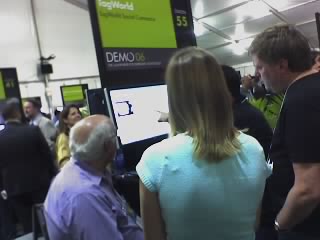TagWorld, said CEO Fred Krueger at breakfast during the Demo conference, is “a MySpace killer.” Big boast. [But with Fred’s background he can do that.] Nonetheless, we’re talking here about killing a business that sold for $580 million (to News Corp.,) and now has 36 million visitors a month. All that aside, TagWorld makes a strong case, will be reaching a million signups at its site soon (after just turning it on three months ago), and has some oh-so-smart money now behind it. See Draper Fisher Jurvetson Funds TagWorld — a deal that went right down to the wire the night before Demo. [What intrigue, huh? Maybe Tim didn’t want Fred getting too chummy with the other VCs hovering around all the hot companies in Phoenix? Tim wasn’t at the conference himself, though I met an associate, Emily Melton.]
Just what is TagWorld? Well, it isn’t just a site, folks. “It’s an online ecosystem,” said Krueger — one that absolutely oozes with tools to support and enable the social web, he told us in his pitch. The big thing it now brings to the game, announced at Demo, is social commerce. “A 14-year-old can build a store in two minutes or less,” he said.
 I conducted a little followup Q&A by email with TagWorld yesterday, and here’s what Fred told me when I asked why his site is better than MySpace: “Because we offer 1 gig of free space to load video, music, photos, blogs, and now we’ve enabled TagWorld members to conduct commerce … the only social network to offer an integrated e-commerce solution. And, unlike other social websites, we provide our users with the ability to create dynamic, multi-page websites without needing an in-depth understanding of html and other web tools. Our drag & drop and one-click features make the social web more accessible to a broader audience.”
I conducted a little followup Q&A by email with TagWorld yesterday, and here’s what Fred told me when I asked why his site is better than MySpace: “Because we offer 1 gig of free space to load video, music, photos, blogs, and now we’ve enabled TagWorld members to conduct commerce … the only social network to offer an integrated e-commerce solution. And, unlike other social websites, we provide our users with the ability to create dynamic, multi-page websites without needing an in-depth understanding of html and other web tools. Our drag & drop and one-click features make the social web more accessible to a broader audience.”
Why did Tim Draper choose to invest in your firm? “Tim has made a career out of finding companies that not only want to change their industry but affect the way that people communicate and conduct business,” said Krueger. “Our goals extend far beyond our niche. We’re passionate about our product and truly believe TagWorld will significantly impact the world as a whole, not just the social web. DFJ shares that vision.”
Care to say anything about the revenue model? “We plan to focus on revenue in the summer and spend the majority of our time (now) on publishing tools and user experience,” said CEO Krueger. “Our revenue plan will include several different approaches and hopefully provide us with enough flexibility so we can offer an alternative to placing ads on consumer’s pages. We want to be the place you move all of your online content to, so we will work hard to preserve that relationship.”
How have you gotten the buzz to get 750,000 signed up so far? And what can we look forward to in your marketing bag of tricks? “By the time you publish, we’ll hopefully have grown to over 800,000. We’ve done some advertising, but most of the buzz is from word-of-mouth,” said Krueger. “We also just launched a national billboard promotion where new TagWorld members can go to www.tagworld.com/billboard to sign up and design a site for a chance to have their TagWorld URL featured on a billboard in their own hometown. Our first winner’s billboard went up this week in North Carolina, and another will go up next week in Pennsylvania. We’ll have five going up on March 15th in LA, and will continue to put up billboards anytime, anywhere throughout the promotion, which is ongoing. Some top TagWorld members will receive personalized t-shirts featuring their TagWorld URLs. We’re running banners for other top TagWorld members, too, which link directly to their site.” But that’s not all folks…Krueger continued: “We’re also concentrating heavily on building our music and video components. We have over 2000 artists using TagWorld to increase their fan base. It’s a great viral marketing tool for bands and other interest groups as members can go to a band or other site and add tunes and videos to their own players.”
 Okay, so you see these guys are serious. But back to the idea of killing off the 800-pound-gorilla competition. Could MySpace really be so fat and happy as to be vulnerable? They sure have challenges going forward regarding parents and other, uh…older folks…getting worked up (rightfully) about safety issues for its mostly underaged users. (A major article in yesterday’s WSJ, page B1, was entitled “News Corp. Goal: Make MySpace Safer for Teens”.) But anyone thinking this web 2.0 behemoth is standing still would do well to read this Red Herring article just out about Helio partnering with MySpace. The gorilla, it seems, still thinks it knows how to grow its big, fat business.
Okay, so you see these guys are serious. But back to the idea of killing off the 800-pound-gorilla competition. Could MySpace really be so fat and happy as to be vulnerable? They sure have challenges going forward regarding parents and other, uh…older folks…getting worked up (rightfully) about safety issues for its mostly underaged users. (A major article in yesterday’s WSJ, page B1, was entitled “News Corp. Goal: Make MySpace Safer for Teens”.) But anyone thinking this web 2.0 behemoth is standing still would do well to read this Red Herring article just out about Helio partnering with MySpace. The gorilla, it seems, still thinks it knows how to grow its big, fat business.
(Inset photo: Walt Mossberg of the Wall Street Journal, left, and his assistant get the pitch from TagWorld’s Evan Rifkin, while CEO Fred Krueger looks on at right.)
Tag: Demo 2006
[Written early Saturday morning in Bloomington, MN…where I’m staying inside as temps outside hover around minus 15.]
 Anyway, GarageBand.com is a going concern on its own, “privately financed” (wink, wink), and wants to be your “free iTunes companion.” And CEO Ali Partovi boasted from stage that his software combined with the iPod “will replace FM radio.” His company’s
Anyway, GarageBand.com is a going concern on its own, “privately financed” (wink, wink), and wants to be your “free iTunes companion.” And CEO Ali Partovi boasted from stage that his software combined with the iPod “will replace FM radio.” His company’s  So, here’s how it works: a consumer wants to send a birthday card. She chooses, say, a three-page card design, then decides which of her digital photos goes on each page and chooses some music to play in the background. The recipient gets the card by e-mail and is able to view it without having to register or download any software. (It runs on Flash, already installed on most PCs.) How many designs will Smilbox have? (And note: these really are designs — they’re too good to call “templates.”) Wright said the company will have 200 online by March and upwards of a thousand by yearend. Granted, many firms are crowding into this photo-sharing business. (Forrester says photo sharing over e-mail is the fourth most popular online activity, after sending text e-mails, researching stuff to buy, and then online purchasing itself.) Yahoo is no doubt the gorilla, especially after its purchase of Flickr last year. See my
So, here’s how it works: a consumer wants to send a birthday card. She chooses, say, a three-page card design, then decides which of her digital photos goes on each page and chooses some music to play in the background. The recipient gets the card by e-mail and is able to view it without having to register or download any software. (It runs on Flash, already installed on most PCs.) How many designs will Smilbox have? (And note: these really are designs — they’re too good to call “templates.”) Wright said the company will have 200 online by March and upwards of a thousand by yearend. Granted, many firms are crowding into this photo-sharing business. (Forrester says photo sharing over e-mail is the fourth most popular online activity, after sending text e-mails, researching stuff to buy, and then online purchasing itself.) Yahoo is no doubt the gorilla, especially after its purchase of Flickr last year. See my  So take this all on faith, would ya? They call it a “connected applications platform,” which lets you synchronize your digital content on multiple PCs, mobile devices, and the web. So you can get at all your stuff with whatever device you’re using at the moment. But it’s not just about accessing and sharing — this looks essentially like a backup company, if you ask me, directed at consumers. It’s focusing now on media files like photos (who isn’t?), but it has its eye on a lot more than that, I suspect. Think synchronization. Maybe a Plaxo or GoToMyPC killer. Please wake me when it’s over…I mean available.
So take this all on faith, would ya? They call it a “connected applications platform,” which lets you synchronize your digital content on multiple PCs, mobile devices, and the web. So you can get at all your stuff with whatever device you’re using at the moment. But it’s not just about accessing and sharing — this looks essentially like a backup company, if you ask me, directed at consumers. It’s focusing now on media files like photos (who isn’t?), but it has its eye on a lot more than that, I suspect. Think synchronization. Maybe a Plaxo or GoToMyPC killer. Please wake me when it’s over…I mean available. One company at Demo,
One company at Demo, 
Recent Comments